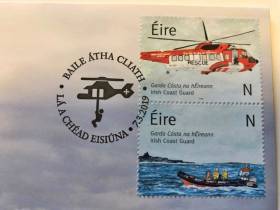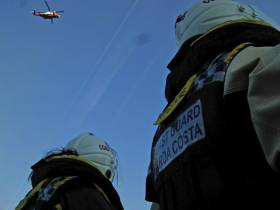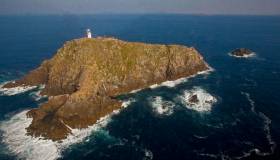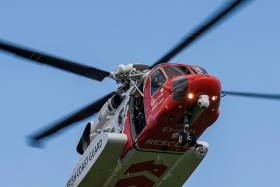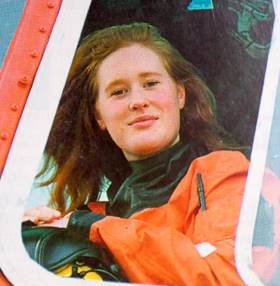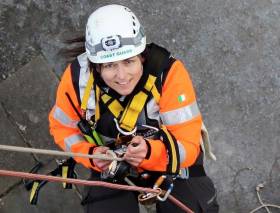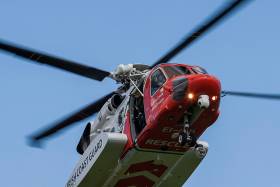Displaying items by tag: Rescue 116
Rescue 116 Captain ‘Would Be So Proud’ Of Young Son, Says Sister On Tragedy’s Second Anniversary
An Irish Coast Guard captain lost in the Rescue 116 tragedy two years ago would be “would be so proud of the little boy” her young son has become.
The sister of Capt Dara Fitzpatrick was speaking on RTÉ Radio 1’s Ray D’Arcy Show yesterday afternoon (Wednesday 13 March) on the eve of the second anniversary of the crash that took the lives of Dara and three other coastguard helicopter crew.
Earlier this month two new stamps were issued in tribute to Capt Fitzpatrick, Capt Mark Duffy, winch operator Paul Ormsby and winchman Ciaran Smith as well as coastguard volunteer Caitríona Lucas who died on a rescue mission a few months previously.
Niamh Fitzpatrick said Dara’s son Fionn was only a baby at the time of the incident on 14 March 2017, but until her death “she gave him such a foundation, she’d be so proud of that”.
She added that the family has found the time around the anniversary “tough”, explaining: “It’s shock the first year, with the trauma, as well as grief and it’s almost like you have to deal with that first before you deal with the grief.”
#Coastguard - Two new postage stamps in tribute to the Irish Coast Guard are based on a painting by a volunteer who died in service, as the Sunday Independent reports.
The painting by Caitríona Lucas, who died during a rescue operation off Kilkee in September 2016, has been adapted into a tribute to both her and the crew of the coastguard helicopter Rescue 116 who were lost in March 2017.
Two stamps show separately a rendering of the Sikorsky S-92 helicopter, and an Irish Coast Guard rescue boat similar to what Caitríona had crewed.
The commemorative stamps were launched at the GPO last week by members of the coastguard and Caitríona’s widower Bernard.
In a joint statement, coastguard units in Skerries, Dun Laighaire and Greystones said their thoughts are with the families of Caitríona, Capt Dara Fitzpatrick, Capt Mark Duffy, winch operator Paul Ormsby and winchman Ciaran Smith.
“This gesture by An Post is heartwarming to us all,” they added.
‘Months’ Before Final Report On Rescue 116 Is Completed
As the second anniversary of the Rescue 116 tragedy approaches, it has emerged that a draft final report into the incident is still months away from completion, according to the Irish Examiner.
The four crew of the Sikorsky S-92 search and rescue helicopter were lost after the crash at Blackrock island off Co Mayo on 14 March 2017.
As previously reported on Afloat.ie, Capt Dara Fitzpatrick died shortly after she was recovered from the scene. The body of Capt Mark Duffy was recovered almost two weeks later. Winch operator Paul Ormsby and winchman Ciaran Smith were lost at sea.
The latest news from the Air Accident Investigation Unit (AAUI) was an interim statement released almost a year agostatement released almost a year ago, which called for “a thorough review of search and rescue aviation operations in Ireland”.
Recommendations from a subsequently commissioned oversight review were accepted by Transport Minister Shane Ross in September last year.
The AAIU has now confirmed that a second interim statement will not be published by 14 March this year, citing work on a draft final report being “at an advanced stage”.
The Irish Examiner has more on the story HERE.
Minister Accepts Recommendations Of Report On Irish Search & Rescue Oversight
#SAR - The report of a team appointed to review “oversight” in Ireland’s search and rescue aviation operations has been published.
Among its short-term recommendations is that the Department of Transport, Tourism and Sport (DTTAS) “formally and clearly assigns” the Irish Aviation Authority (IAA) “with responsibility for the legal and safety oversight” of civil aviation SAR.
In the medium term, it is recommended that the IAA be directed to develop “clear and unambiguous” regulatory material for SAR “that is appropriate to the scale and complexity of the national aviation system”, and that roles and responsibilities are “assigned appropriately … [with] a consistent, shared understanding”.
The report says it is “evident that the regulatory arrangements for search and rescue are a hybrid of maritime and aviation depending on which assets are deployed and in what circumstances.”
But it also stresses that Ireland “is not exceptional” in this regard, and that its recommendations show “learnings which will be relevant to other jurisdictions”.
Transport Minister Shane Ross has considered the report and accepts in full its 12 recommendations.
The review was conducted as a direct response to the Air Accident Investigation Unit’s (AAIU) interim statement in March as its own investigation into the Rescue 116 incident remains ongoing after more than a year due to its “depth and breadth”.
An international team of aviation and SAR experts worked on the report, which was completed in early August and submitted to the AAIU along with a series of follow-up actions to ensure full implementation of the its recommendations.
The AAIU says it has had an opportunity to consider the report in the context of its “wide-ranging investigation into the R116 accident and is happy that its publication does not jeopardise any other element of its ongoing investigation.”
As the report states, the review did not examine the specific circumstances in relation to the Rescue 116 accident and as such, there is no intention to establish any causal link between their findings and the accident.
Speaking upon the publication of the report today (Friday 21 September), Minister Ross said: “I have instructed that all necessary steps be taken without delay to ensure speedy implementation of all of the recommendations.
“As the report explains, search and rescue oversight and regulation is a complex matter, and international regulation is still endeavouring to keep pace with practice on the ground.
“However, we now have an opportunity in Ireland — and a blueprint – to make meaningful improvement to our current oversight structures, and in doing so set a benchmark for other jurisdictions.”
The minister said he will continue to provide updates to the AAIU on the progress in implementing these actions.
The report is available as a PDF to read or download from the DTTAS website HERE.
Irish SAR Review Points To Confusion Among Agencies
#SAR - A team appointed to review Irish search and rescue operations in the wake of last year’s fatal Rescue 116 crash has identified “several sources of confusion and potential conflicts of interest among the agencies involved”.
RTÉ News reports on the as-yet unpublished report from an international panel of aviation and SAR experts appointed earlier this year by Transport Minister Shane Ross.
The panel did not examine the Rescue 116 crash at Blackrock, which is subject to its own report, and was tasked only with reviewing matters in relation of “oversight” of Irish SAR operations.
Their report says that confusion over the roles of the various agencies involved in civil aviation SAR has “resulted in a lack of shared understanding of roles and responsibilities”.
RTÉ News has more on the story HERE.
Items Recovered Off Achill Could Be From Rescue 116 Crash
#Rescue116 - RTÉ News reports that a lifejacket and helmet thought to be from the Rescue 116 crash last year have been recovered off Achill Island.
Local gardaí confirmed that the items were brought ashore by fishermen about a mile offshore last Thursday 12 July.
The find comes more than nine months after a lifejacket and helmet believed to be from the downed Sikorsky S-92 helicopter washed up on a beach near Blacksod in Co Mayo.
It also comes 16 months after the tragedy that took the lives of four Irish Coast Guard personnel.
Capt Dara Fitzpatrick died shortly after she was recovered from the scene at Black Rock on 14 March 2017. The body of Capt Mark Duffy was recovered almost two weeks later.
Winch operator Paul Ormsby and winchman Ciaran Smith were lost at sea.
The Air Accident Investigation Unit’s probe of the incident remains ongoing.
Ross Appoints Team To Review Search & Rescue ‘Oversight’ In Wake Of Rescue 116 Tragedy
#Rescue116 - Transport Minister Shane Ross has appointed an international team to review Irish SAR operations in the wake of last year’s fatal Rescue 116 crash, as The Irish Times reports.
The team, led by former European Aviation Safety Agency rulemaking director Prof Jules Kneepkens, includes former Bristol Helicopters coastguard SAR commander Rowan Greenwood, and Milen Dentchev, safety oversight auditor with the International Civil Aviation Organisation.
They have been given two months to report back to the minister with their findings.
The appointment follows March’s interim report from the Air Accident Investigation Unit (AAIU) into the tragedy at Black Rock off Co Mayo on 14 March 2017, which cost the lives of four experienced Irish Coast Guard personnel.
Capt Dara Fitzpatrick was recovered at the scene but died shortly after. The body of Capt Mark Duffy was found almost two weeks later, while winch operator Paul Ormsby and winchman Ciaran Smith were not recovered.
As previously reported on Afloat.ie, the AAIU called for “a thorough review of search and rescue aviation operations in Ireland” as its own investigation into the Rescue 116 incident remains ongoing after more than a year due to its “depth and breadth”.
Minister Ross says the review’s term of reference will “take account of the various findings made in the AAIU’s interim statement in relation to oversight.”
The Irish Times has more on the story HERE.
Tributes To Lost Coastguard Crew At ‘People Of the Year’ Awards
#Rescue116 - The 43rd annual People of the Year awards tomorrow night (Sunday 15 April) will see honours go to the Irish Coast Guard as a tribute to the crew of Rescue 116, as BreakingNews.ie reports.
In addition, the people of Erris in Co Mayo will be noted for their contributions to the search and rescue operation following the tragic loss of the helicopter’s four crew — Capt Dara Fitzpatrick, Capt Mark Duffy, Paul Ormsby and Ciarán Smith — on 14 March 2017.
Caitríona Lucas, the coastguard volunteer who died in a search operation off Kilkee a few months prior, will also be remembered on the evening, broadcast live on RTÉ One tomorrow from 9.30pm.
“The selfless actions of those who put their lives on the line, for the safety of others, means Caitríona, Dara, Ciáran, Mark and Paul will remain an inspiration to us all,” said Gerard O’Flynn, search and rescue operations manager with the Irish Coast Guard.
All five are set to feature in a new commemorative stamp colllection next year, as previously reported on Afloat.ie.
New Stamp Collection To Remember Lost Search & Rescue Personnel
#Coastguard - Next year’s commemorative stamp programme from An Post will feature a tribute to the four coastguard crew lost in the Rescue 116 tragedy one year ago.
RTÉ News reports that Caitriona Lucas, the coastguard volunteer who died during a rescue mission in September 2016, will be included as part of a series paying tribute to the work of the Irish Coast Guard.
Among other stamps due in 2019 will be one to mark 100 years since the first non-stop transatlantic flight from Newfoundland to Galway by British aviators Alcock and Brown.
Interim Statement On Rescue 116 Tragedy Calls For ‘Thorough Review’ Of Irish SAR Operations
#Rescue116 - The Air Accident Investigation Unit has called for “a thorough review of search and rescue aviation operations in Ireland” in the wake of the Rescue 116 tragedy one year ago.
Four Irish Coast Guard crew — Capt Dara Fitzpatrick, Capt Mark Duffy, winch operator Paul Ormsby and winchman Ciaran Smith — were lost when their Sikorsky S-92A helicopter went down at Black Rock island, off Blacksod in Co Mayo, in the early hours of 14 March 2017.
The AAIU confirmed in January that due to the “depth and breadth” of its investigation into the incident, a final report would not be completed within the first year, and progress would be detailed in an interim statement.
Published on Friday (16 March) days after commemorations in Mayo for the four Rescue 116 crew, this statement called on the Minister for Transport to conduct “a thorough review” of air-based SAR “to ensure that there are appropriate processes, resources and personnel in place to provide effective, continuous, comprehensive and independent oversight of all aspects of these operations.”
The statement also highlighted an issue with the “coarseness” of position data recorded by the helicopter’s flight data recorder, suggesting upgrades or modifications “to ensure that the latitude and longitude information recorded on the Flight Data Recorder reflects the most accurate position information available during all flight regimes and mission profiles.”
And it urged coastguard helicopter operator CHC Ireland to conduct an internal review of its safety management systems, or SMS, after the investigation raised “concerns regarding its efficacy”.
Interim safety recommendations included in last April’s preliminary report remain open, the AAIU says.
Minister for Transport Shane Ross welcomed the publication of the AAIU interim statement on Friday, and said he has asked his department to ensure that the recommended review of SAR aviation operations “is instigated without delay”.
“The aim of this review will be to ensure that our arrangements in this regard are sufficiently robust and measure up to international best practice models,” Minister Ross added.
Noting the length of the investigation, the minister said it was “important to emphasise” that the AAIU’s work remains in progress.
“Whilst I understand the ongoing public interest in this matter, it is vital that the AAIU is given the time and space to complete its work and report on its findings,” he said. “As such, I am not in position to comment further on the issues surrounding it.”




























